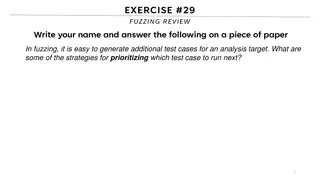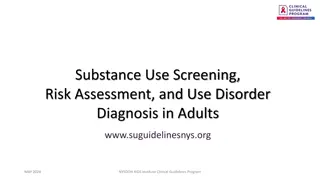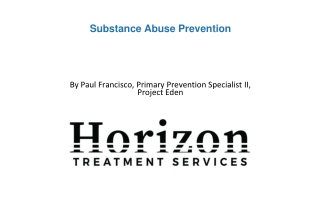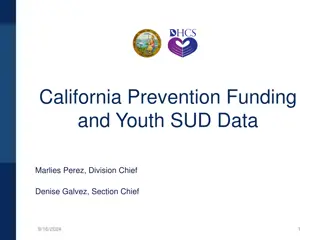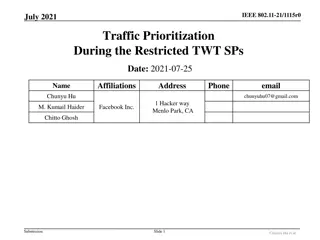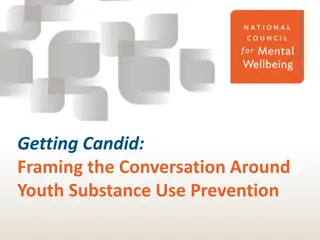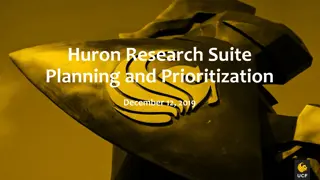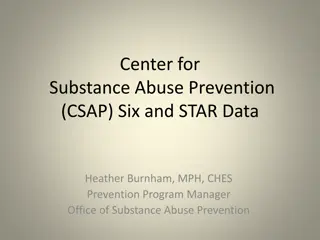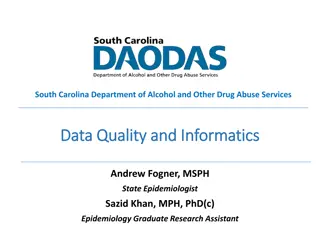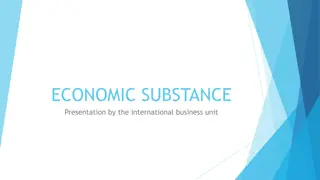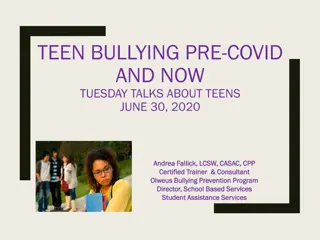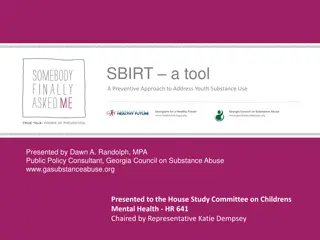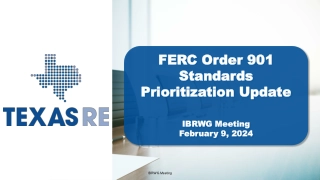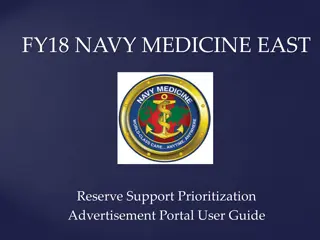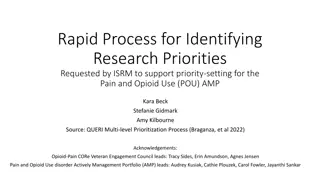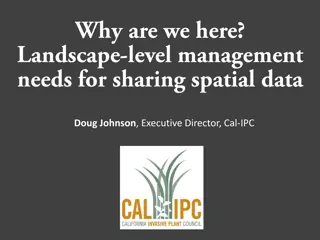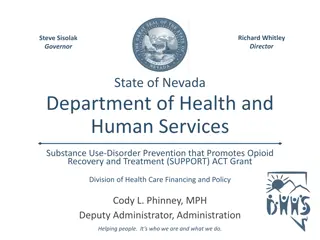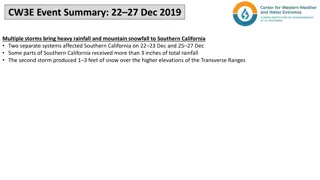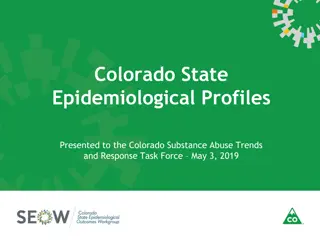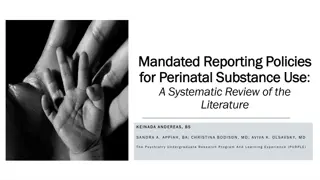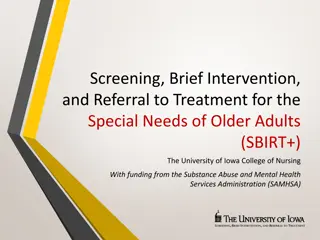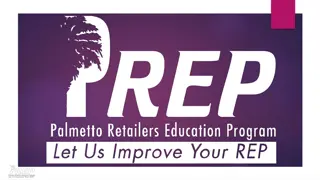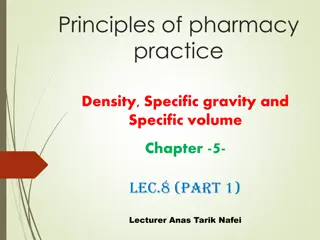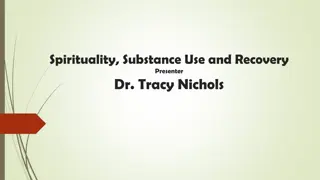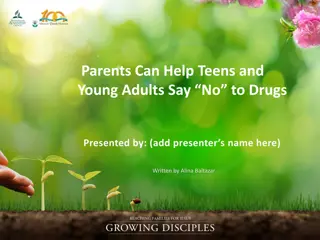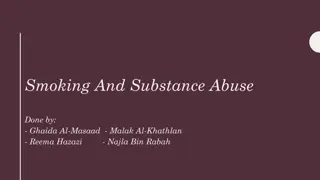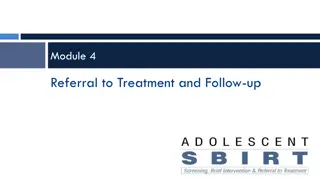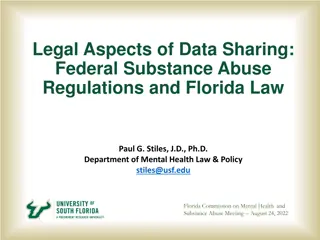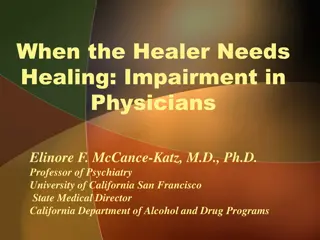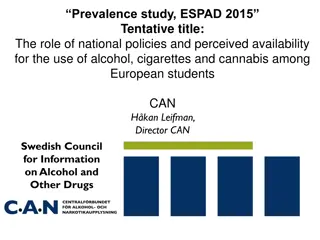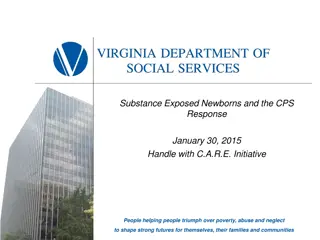SEOW Substance Prioritization for Prevention Planning in December 2017
The Statewide Epidemiological Outcomes Workgroup (SEOW) conducted prioritization of substances to support prevention planning, focusing on factors like magnitude, impact, and changeability across different age groups. Members considered various aspects including consumption data, risks, accessibility, treatment admissions, and policy implications. Priority substances for the 12-17 age group included electronic nicotine devices, PCP, hallucinogens, fentanyl, and others. The prioritization was based on the number of people affected, consequences, and the impact on population and systems like economy and healthcare.
Download Presentation

Please find below an Image/Link to download the presentation.
The content on the website is provided AS IS for your information and personal use only. It may not be sold, licensed, or shared on other websites without obtaining consent from the author. Download presentation by click this link. If you encounter any issues during the download, it is possible that the publisher has removed the file from their server.
E N D
Presentation Transcript
Statewide Epidemiological Outcomes Workgroup (SEOW) Prioritization of Priority Substances December, 2017
SEOW Prioritization of Substances SEOW Prioritization of Substances Prioritization was undertaken to support DMHAS prevention planning Members participated in an online survey, based on substance data presented by UCHC CPES, and epidemiological profiles distributed to respondents Prioritization based on magnitude, impact, and changeability 12-17, 18-25, 26-65, and 66+ age groups 12 members completed the survey
Respondents considered: Respondents considered: Consumption, use data Risks and consequences of use Accessibility of substances Gateway potential Treatment admission data Overdose and death data Cost of treatment Relaxed laws around marijuana and potential legalization Long term effects Target population (the work we do) State demographics and subpopulations affected Personal experience Potential for policy decisions to address substance State s capacity to address the problem
Rank of Priority Substances, 12-17 Age Group Also of concern: Electronic nicotine devices PCP Hallucinogens and party drugs Fentanyl Inhalants 1 2 3 Alcohol NMUPD Marijuana Tobacco Heroin Cocaine
SEOW Substance Prioritization based on Magnitude, 12-17 Age Group 83 How many people are affected and how serious are the consequences? 55 45 18 9 0 Alcohol NMUPD Marijuana Tobacco Heroin Cocaine
SEOW Substance Prioritization based on Impact, 12-17 Age Group 100 How does this affect the population and systems such as the economy, healthcare, and judicial? 36 27 27 27 9 Alcohol NMUPD Marijuana Tobacco Heroin Cocaine
SEOW Substance Prioritization based on Changeability, 12-17 Age Group What is the State s capacity and readiness to address this problem? 45 36 27 27 18 0 Alcohol NMUPD Marijuana Tobacco Heroin Cocaine
Rank of Priority Substances, 18-25 Age Group Also of concern: Illicit Fentanyl (cut into other drugs) Prescription stimulants Hallucinogens 1 2 3 Alcohol Heroin NMUPD Tobacco Marijuana Cocaine
SEOW Substance Prioritization based on Magnitude, 18-25 Age Group 90 How many people are affected and how serious are the consequences? 40 40 30 20 0 Alcohol NMUPD Marijuana Tobacco Heroin Cocaine
SEOW Substance Prioritization based on Impact, 18-25 Age Group 100 How does this affect the population and systems such as the economy, healthcare, and judicial? 30 30 20 10 0 Alcohol NMUPD Marijuana Tobacco Heroin Cocaine
SEOW Substance Prioritization based on Changeability, 12-17 Age Group What is the State s capacity and readiness to address this problem? 30 20 20 20 0 0 Alcohol NMUPD Marijuana Tobacco Heroin Cocaine
Rank of Priority Substances, 26-65 Age Group Also of concern: Illicit Fentanyl (cut into other drugs) Benzodiazepines, in combination with other drugs (Alcohol, Opioids) 1 2 3 Alcohol NMUPD Heroin Marijuana Tobacco Cocaine
SEOW Substance Prioritization based on Magnitude,26-65 Age Group 78 How many people are affected and how serious are the consequences? 44 44 33 11 0 Alcohol NMUPD Marijuana Tobacco Heroin Cocaine
SEOW Substance Prioritization based on Impact, 26-65 Age Group How does this affect the population and systems such as the economy, healthcare, and judicial? 90 60 56 44 0 0 Alcohol NMUPD Marijuana Tobacco Heroin Cocaine
SEOW Substance Prioritization based on Changeability, 26-65 Age Group 33 What is the State s capacity and readiness to address this problem? 20 11 0 0 0 Alcohol NMUPD Marijuana Tobacco Heroin Cocaine
Rank of Priority Substances, 66+ Age Group Also of concern: Benzodiazepines Prescription management Mental health issues 1 2 3 Alcohol NMUPD Tobacco Marijuana Heroin Cocaine
SEOW Substance Prioritization based on Magnitude,66+ Age Group 56 56 How many people are affected and how serious are the consequences? 11 0 0 0 Alcohol NMUPD Marijuana Tobacco Heroin Cocaine
SEOW Substance Prioritization based on Impact, 66+ Age Group How does this affect the population and systems such as the economy, healthcare, and judicial? 56 56 56 44 0 0 Alcohol NMUPD Marijuana Tobacco Heroin Cocaine
SEOW Substance Prioritization based on Changeability, 12-17 Age Group What is the State s capacity and readiness to address this problem? 22 22 11 0 0 0 Alcohol NMUPD Marijuana Tobacco Heroin Cocaine
State Epidemiological State Epidemiological Outcomes Workgroup (SEOW) Outcomes Workgroup (SEOW) 2018 Meetings 2018 Meetings Wednesday, March 21 (postponed) Wednesday, June 20 Wednesday, September 19 Wednesday, December 19


